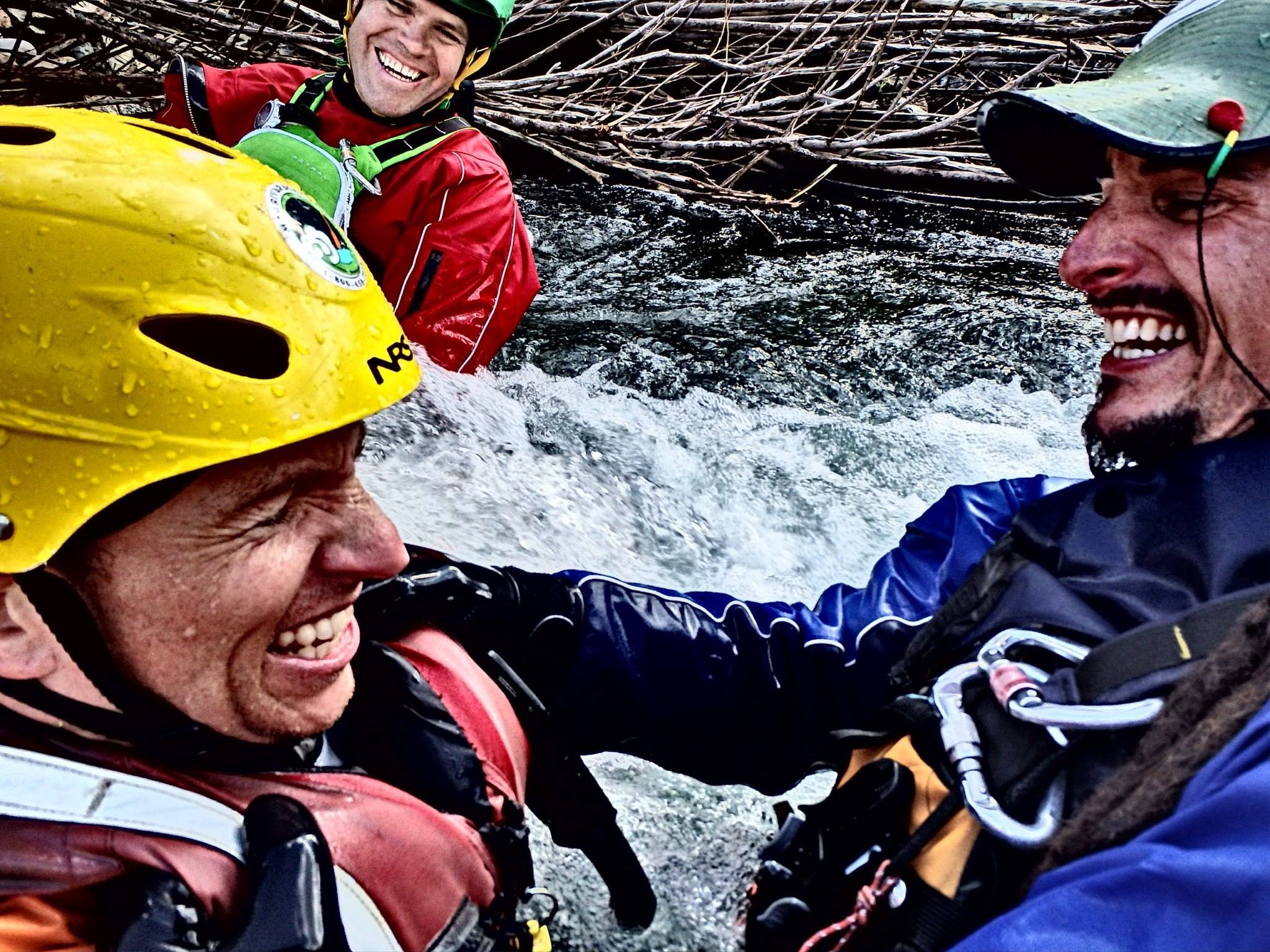Swiftwater Skills In Action
The skills developed in a swift water rescue course may be needed during any kind of rafting excursion, such as a short day trip or a multi-day adventure. No matter the length or difficulty of the journey, always be aware of any and all dangers and predicaments that might arise along the way. For instance, just because the stretch of river you’ve chosen to run has no named rapids does not mean other significant obstacles won’t exist. Rapids are usually the most exciting and renowned challenges on a river, but strainers, sand bars, rock gardens, dead-end channels and other diversions can also cause as much or more drama on the river. Flipping a boat might be the most dramatic way to cause a scene on a river trip, but pinning a boat would have to be the most inconvenient.
Righting a flipped raft is straightforward and requires little more than strength, a flip-line, and teamwork. If the boat is not fully loaded, you might only need one person to get the job done. If the boat is a massive 18-foot gear hauler like those used on Grand Canyon expeditions, you might need a little more muscle. The first step is getting on top of the upside-down raft, followed by attaching one or several flip lines to secure points along the side of the raft. Then, all that you or your team has to do is grab the flip lines, step to the opposite side of the raft, rock the boat towards and away from you using the flip line and your feet, and hold on while propelling yourself backwards off the side of the boat, pulling the raft upright as you go. You can either reflip the boat in the current or bring it to shore - this must be decided case by case depending on which is safer. This process can certainly become more complicated if there are other components such as shallow or rocky water, downstream rapids, or not enough strength to right the raft, but the process does remain the same.
A situation involving a pinned raft will always be unique and thus will always require a more complex approach. Is the raft pinned on one large rock in the middle of a mostly clear channel, or is it pinned on several smaller rocks among many in the river? Is it wedged between two rocks, or a rock and a tree? Is it pinned on a mid-river strainer? No matter the situation, it is likely that there is a huge amount of pressure being forced upon the raft as it upsets the flow of the river. To unpin that raft is to fight against the enormous power of flowing water. One factor you will hope to have is an ample amount of time. If the raft is pinned, where are it’s passengers? This is a crucial initial consideration - your first reaction should be to locate all of the passengers and ensure their safety. Time becomes urgent if there are people pinned alongside or underneath the raft. Once all members of the group are safely gathered, you have the time to take a breath and formulate a plan. Drink some water, eat a snack, and consider your options.
While devising a way to unpin the raft, consider accessibility to the raft, upstream and downstream obstacles, what part of the boat is pinned, the gear you have with you, the number of people and rafts, and environmental factors. If you have a safe way to get someone to the boat, the first option to try is to change the weight of the boat by standing on one end or the other, shifting gear around, or bouncing up and down on the tubes. Enough weight could be readjusted to allow the current to find a stronghold and force the boat out of its pinned position, hopefully shifting it free for good. If this method proves to be inadequate, you can try changing the shape of the boat by deflating one or several tubes. This can force the water to place pressure on different areas of the raft, which might reposition the raft and also set it free.
If the boat is still pinned after these efforts, it is time to involve ropes. Be sure to attach the rope to the boat frame or several points of contact, because all of the forces involved in freeing the boat could tear a D-ring from its tube. Once secure, try a group pull at first, in which all the people on shore pull on the boat from whatever angle seems most appropriate. If the boat remains obstinate and pinned, it is time to discuss the use of mechanical advantage. There are a myriad of mechanical systems that can be used, but the most useful will be a simple 3:1 system. Start by choosing an object on shore, such as a large rock or tree that won’t move under the force of the pull, and use webbing or rope to create an anchor. Connect a pulley to this anchor and bring the rope connected to the boat through this pulley. Along the rope between the anchor and the raft, attach two prusiks - one as close to the boat as possible and the other near the anchor. You will connect this second prusik to the anchor with a carabiner. Place a pulley on the prusik nearer to the boat and feed the rope through this pulley. From here, you can start to pull using this mechanical advantage system, which will triple your effort in freeing the pinned raft. Once your group’s pinned boat is finally freed, you will be able to continue on downstream, hopefully with enough daylight left to make it to a desired camp or the boat ramp. You will also likely feel the need for extreme caution throughout the rest of the journey, as a pinned boat experience is not easily forgotten.
Practicing safety on the river does not mean that you cannot or should not be allowed to enjoy yourself. Rafting is meant to be an exhilarating and fulfilling physical connection with the river. This relationship is tangible - you feel it in the coaxing tug of a slow current beneath your raft, and you feel it when your stomach drops as you slide down a glassy tongue into whitewater. The beauty of multi-day river expeditions is in the escape - you exist on the river’s time and live by it’s rules, a wholly different way of life than what we are accustomed to. You wake in the morning to the light of the sun, float the river until you get to where you’d like to go for the day, and are surprised around every bend. As long as the group is well-trained, communicates often, and makes responsible choices, you should feel free to relax and embrace your surroundings. It is incredibly important that you trust in the members of your group on a multi-day expedition, as they will be your fellow rescuers if something were to go amiss. There will not be a great catastrophe that leads to a dramatic or drawn out rescue on every trip you embark upon. Some trips will be blissfully undemanding. Every excursion will present something extraordinary, but if you are prepared and responsible, the extraordinary will hopefully be no more dangerous than a night of fantastic shooting stars, or a particularly delicious cast-iron desert prepared on hot driftwood coals.
Multi-day trips will take you on voyages tens to hundreds of miles along a river, likely in a faraway wilderness tucked in the depths of a canyon. There is a romantic quality to this aspect of river expeditions, in that you and your companions have only each other to rely on against whatever appears on the horizon, and there is nobody else for miles. Nowadays, we have technology like spot devices to connect us to outsiders, but even with this ability to communicate long distance, the distance remains. Remoteness on river trips is an element that every boater must prepare for, because if a real medical emergency were to present itself, help would be a long way off. It is important that some members of the group possess at least basic first aid knowledge and to distinguish one group member as a medical lead for the trip. Then, if a situation were to arise, there would not be chaos but order as everyone would look to one person to delegate tasks and provide options to discuss. At some point with a medical or traumatic injury, there is a time when the group must decide whether or not they must try to evacuate the affected person. This might involve calling in for a Search and Rescue team, or it might require the group to push out of the backcountry as fast as possible, rafting from dawn and into the night if necessary.
The easiest and most fulfilling path to a life of uncomplicated multi-day river expeditions is to take a swiftwater rescue course. Not only does such a course teach tactile skills such as creating mechanical advantages and righting a flipped raft, but it also imparts critical thinking skills on its students. A viable plan does not present itself easily, especially in the most complex cases on the river. It must be formed by evaluating certain risks, judging time sensitivity, and considering all possible outcomes. Swiftwater rescue scenarios are designed to imitate the most problematic situations so that students can practice devising and enacting their own plans in safe and controlled environments. These scenarios can then be analyzed by student and instructor alike, so that everyone involved can comprehend what the proper response would have been. A multi-day expedition that includes Swiftwater-trained boaters provides unparalleled peace of mind and a sense of confidence that the trip will run smoothly and safely, no matter the hazards that emerge along the way.
Blog content provided by guest author and professional river guide, Bridget Guthrie, (RRC).





